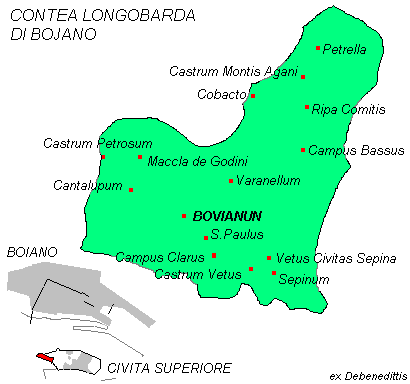![]() Settlements in the
longobard period
Settlements in the
longobard period
The
migratory movements of populations that in the Middle Ages moved
south in search of new land to settle had a strong impact on
Molise, a naturally weak region, which left signs that are still
quite evident today (the name “Ripabottoni”, for instance, is
said to originate from Ripaghotorum, while
“Macchiagodena” originates from Maccla-Godini).
After the Byzantines, the region was occupied by the Longobards
and incorporated in the Duchy of Benevento; later the Duchy was
broken up, and around the year 1000 it was divided into 34
counties, six of which had their seat in Molisian centres (Boiano,
Venafro, Isernia, Trivento, Larino and Termoli). Many Molisian
castles, such as Campobasso, Roccamandolfi (the Longobard rocca
Maginulfi), Termoli, Lucito, Colletorto, Guardialfiera,
Castelgiudice, Civitacampomarano and S.Maritino in Pensilis are
believed to date back to the Longobard era. The castles of Colli
al Volturno, Cerro al Volturno, Scapoli, S.Maria Oliveto and
others were built at the beginning of the 10th century
in the area of the Terra Sancti Vincentii. The villages
were characterised by houses and vegetable gardens protected by a
palisade and tower, while all around new land was cleared of trees
and put under cultivation. The Longobard fortifications are
difficult to recognise because of the numerous transformations
that occurred in later periods.
The Longobard presence is sometimes indicated by the survival of
significant toponyms, such as the name “fara” (village,
family).
During the Longobard period Molise suffered several assaults by
the Saracens. Their presence is testified by toponyms such as
Macchia Saracena, Torrente Saraceno, Ripa Saracena...
 |